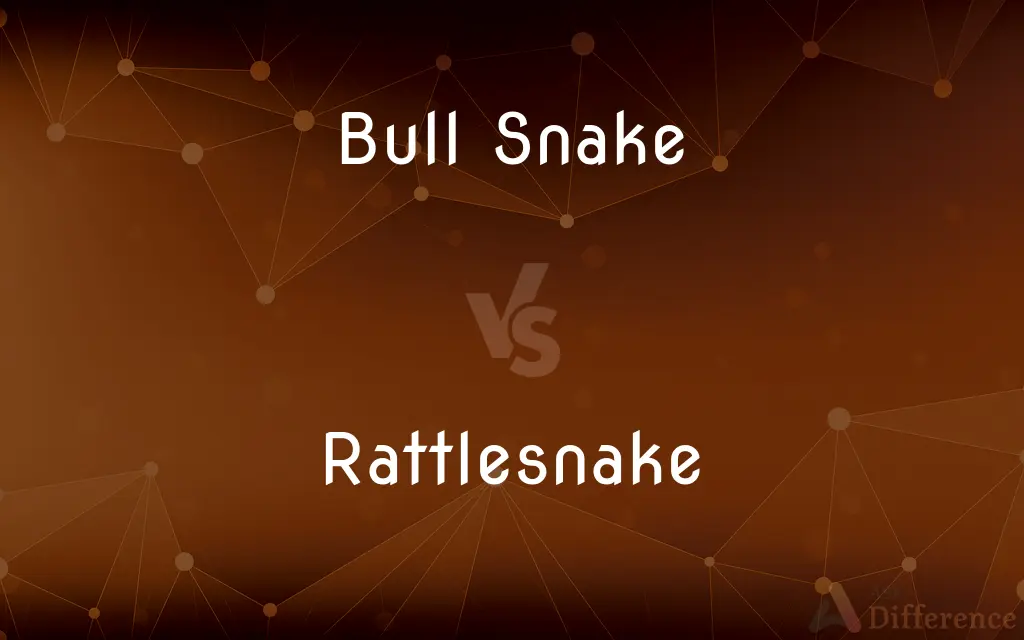Bull Snake vs. Rattlesnake — What's the Difference?
Edited by Tayyaba Rehman — By Fiza Rafique — Published on December 24, 2023
Bull snakes are non-venomous constrictors, while rattlesnakes are venomous pit vipers known for their distinctive rattling tails.

Difference Between Bull Snake and Rattlesnake
Table of Contents
ADVERTISEMENT
Key Differences
Bull snakes and rattlesnakes are both native to North America, but they differ significantly in terms of behavior, appearance, and diet. While both are sizable reptiles, their interactions with humans and their overall roles in the ecosystem differ.
Bull snakes are known for their strong constricting ability. When they catch prey, they coil around it and squeeze until it's subdued. Rattlesnakes, on the other hand, use venom to immobilize or kill their prey. They strike with lightning-fast reflexes, injecting venom through their long, hollow fangs.
Bull snakes have a patterned appearance which, to the untrained eye, can look somewhat similar to certain rattlesnake species. This mimicry can deter potential predators. Rattlesnakes, however, have a distinctive rattle at the end of their tail, which they shake as a warning when threatened.
Both bull snakes and rattlesnakes play crucial roles in controlling pest populations. Bull snakes primarily feed on rodents, birds, and bird eggs. Rattlesnakes also prey on rodents, keeping their numbers in check, which can be particularly beneficial for farmers and human habitation areas.
One interesting aspect of the bull snake's behavior is its ability to mimic the sound of a rattlesnake by rapidly shaking its tail in dry leaves or grass, possibly to deter potential threats. Rattlesnakes, with their actual rattle, use this sound genuinely as a warning signal, signifying that they are ready to defend themselves if necessary.
ADVERTISEMENT
Comparison Chart
Venom
Non-venomous
Venomous
Method of Subduing Prey
Constriction
Venom injection
Tail Feature
Can mimic rattling by shaking tail in dry foliage
Distinctive rattle at the end of the tail
Diet
Rodents, birds, bird eggs
Primarily rodents
Threat to Humans
Generally not a threat
Can be dangerous due to venomous bite
Compare with Definitions
Bull Snake
Bull snakes are large, non-venomous constrictors.
The bull snake wrapped itself around its prey, squeezing tightly.
Rattlesnake
Rattlesnakes are venomous snakes known for their rattling tail.
The rattlesnake warned the approaching hiker with its distinctive rattle.
Bull Snake
Bull snakes have patterned scales, often mistaken for rattlesnakes.
From a distance, the markings on the bull snake resembled those of a rattlesnake.
Rattlesnake
Rattlesnakes belong to the pit viper family.
The rattlesnake's heat-sensing pits help it detect warm-blooded prey.
Bull Snake
Bull snakes can imitate the sound of a rattling tail.
When threatened, the bull snake vibrated its tail amidst dry leaves.
Rattlesnake
Rattlesnakes play a role in controlling rodent populations.
The presence of rattlesnakes in the area meant fewer troublesome rodents.
Bull Snake
Bull snakes primarily feed on rodents and birds.
Farmers appreciate bull snakes for their ability to control rodent populations.
Rattlesnake
Rattlesnakes have a heat-sensing pit between their eyes and nostrils.
The rattlesnake detected the warm body of the rabbit using its heat-sensing pit.
Bull Snake
Bull snakes are beneficial for controlling pest populations.
With a bull snake around, the farm saw fewer rats and mice.
Rattlesnake
Rattlesnakes strike quickly to inject venom into their prey.
With a swift motion, the rattlesnake struck the mouse, delivering a venomous bite.
Bull Snake
Any of several large harmless rodent-eating North American burrowing snakes
Rattlesnake
Any of various venomous pit vipers of the genera Crotalus and Sistrurus of the Americas, having at the end of the tail a series of loosely attached, horny segments that can be vibrated to produce a rattling or buzzing sound.
Rattlesnake
Any of various venomous American snakes, of genera Crotalus and Sistrurus, having a rattle at the end of its tail.
Rattlesnake
Any one of several species of venomous American snakes belonging to the genera Crotalus and Caudisona, or Sistrurus; sometimes also called rattler. They have a series of horny interlocking joints at the end of the tail which make a sharp rattling sound when shaken. The common rattlesnake of the Northern United States (Crotalus horridus), and the diamondback rattlesnake (also called diamondback rattler, and diamondback) of the South and East (Crotalus adamanteus) and West (Crotalus atrox), are the best known. See Illust. of Fang.
Rattlesnake
Pit viper with horny segments at the end of the tail that rattle when shaken
Common Curiosities
Do rattlesnakes always rattle before striking?
While rattlesnakes often rattle as a warning, they do not always do so before striking.
Can bull snakes and rattlesnakes coexist in the same habitat?
Yes, both species can be found in similar habitats, often coexisting in the same areas.
What should one do if bitten by a rattlesnake?
Seek medical attention immediately, and keep the affected limb immobilized.
Why do bull snakes mimic rattlesnake sounds?
Mimicking a rattlesnake may deter potential predators or threats.
How many species of rattlesnakes are there?
There are over 30 known species of rattlesnakes.
How do bull snakes subdue their prey?
Bull snakes use constriction to suffocate and subdue their prey.
Are bull snakes beneficial to humans?
Yes, bull snakes help control rodent populations, making them beneficial for farmers and households.
Can you tell a bull snake from a rattlesnake by looking at its tail?
Yes, rattlesnakes have a distinctive rattle at the end of their tails, while bull snakes do not.
Do bull snakes lay eggs?
Yes, bull snakes lay eggs, which they bury in sandy or loose soil.
Are bull snakes venomous?
No, bull snakes are non-venomous constrictors.
Are rattlesnake bites fatal to humans?
While rattlesnake bites can be very dangerous and potentially fatal, with prompt medical treatment, most victims recover.
How does the venom of a rattlesnake affect its prey?
Rattlesnake venom can immobilize, kill, and begin the digestion process of its prey.
Are rattlesnakes protected species?
Some species or populations of rattlesnakes are protected in certain areas, but it varies by region and species.
How long can bull snakes grow?
Bull snakes can grow up to 8 feet long, but most are between 4 to 6 feet.
How do rattlesnakes get their rattle?
A rattlesnake's rattle is made of interlocking segments that are added with each molt.
Share Your Discovery

Previous Comparison
English Literature vs. Literature in English
Next Comparison
Partnership Firm vs. CompanyAuthor Spotlight
Written by
Fiza RafiqueFiza Rafique is a skilled content writer at AskDifference.com, where she meticulously refines and enhances written pieces. Drawing from her vast editorial expertise, Fiza ensures clarity, accuracy, and precision in every article. Passionate about language, she continually seeks to elevate the quality of content for readers worldwide.
Edited by
Tayyaba RehmanTayyaba Rehman is a distinguished writer, currently serving as a primary contributor to askdifference.com. As a researcher in semantics and etymology, Tayyaba's passion for the complexity of languages and their distinctions has found a perfect home on the platform. Tayyaba delves into the intricacies of language, distinguishing between commonly confused words and phrases, thereby providing clarity for readers worldwide.












































